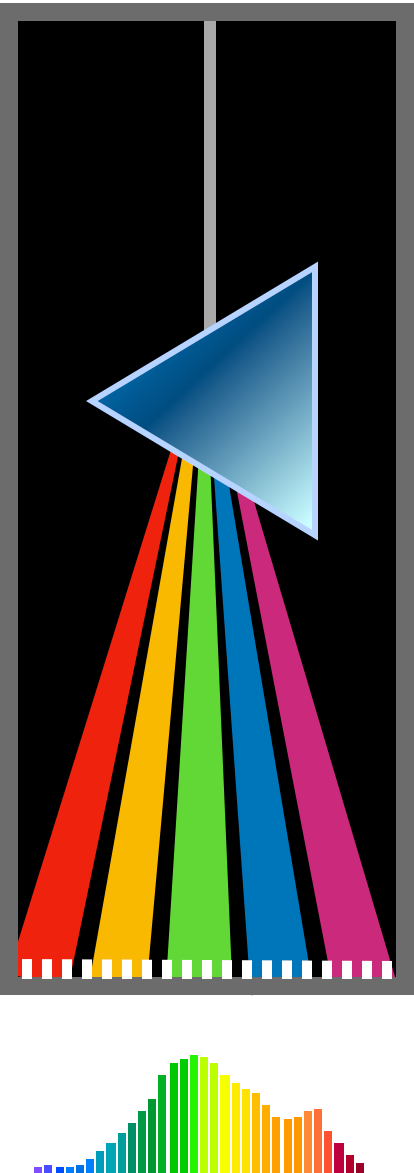Spectrophotometer vs Colorimeter
How do the instruments see color?
| Colorimeter | Spectrophotometer | |
 |
 |
|
| Sensor | filtered photodetectors | Monochromator +photodetectors array |
| Bandwith | visible light only | UV + VIS + IR |
| Output | Colorimetrical coordinates | Spectral Curve |
| Fluorescence (OBAs) | |
|
| Color Inconstancy | |
|
| Metamerism |
Spectrophotometers
Spectrophotometer uses Monochromator to split light into the spectrum, the result is a curve that shows the distribution of energy absorbed by the object. In the graphic industry typical bandwidth is 10nm (for some measurements 5nm). The typical range is 380 -720 nm or 400-700, which means that the whole spectrum is divided into 31+ bins. If we go deeper we can see that in most cases sensor has even more photoelements. For example, the X-Rite I1 Pro sensor contains 128 pixels which means a single pixel has about 3.5 nm. Most of the spectrophotometer has integrated source of light that can be controlled to simulate requirements of the different M-conditions
A spectrophotometer is analyzing how the object absorbs or reflects light in the spectrum his kind of information can be used to calculate the influence of changes in Lighting and the Observer on color appearance. Once the object is measured we can change the parameters of the calculation and predict various scenarios. That feature is not achievable using colorimeters. If we collect spectral data using more than one Illuminant (M-conditions) we can quantify and simulate also fluorescence (e.g. quantify OBAs).
Colorimeter
Typical Colorimeter covers energy readings along the visible spectrum by using filtered photodetectors (e.g. silicon photodiodes) to colorimetrical coordinates. The general rule is similar to the one in the case of the human eye, where, in the retina, there are rods that are pigmented at selected wavelengths. Colloquially speaking, it's like detectors equipped with filters. Even if the colorimeter uses a color filter array the final result is color definition expressed by three coordinates.
In practice, colorimeters are good for Display calibration, but not for Prints. Colorimeters have built-in a source of the light without the ability to control UV content, which is why they cannot cope with the fluorescence effect, and the lack of spectral recording makes it impossible to simulate different lighting conditions or estimate metamerism. The Color Inconstancy Index or the Metamerism Index will therefore not be available.
CC Nano
CC Nano is an RGB camera that uses high-quality LED light to take a picture. By applying advanced color management algorithms RGB data are converted into Lab values. The huge advantage of the nano is the ability to evaluate parameters related to the surface that other instruments can't do. From this standpoint, we should NOT expect the same results from the camera and spectrophotometer. It is also important that all cases where the UV component of the light is important ( OBAs, fluorescence) are not managed accurately or can't be detected/analyzed at all!
CC Nano is great instruments thanks to features related to surface effects, uniformity, and special effects. It also offers dominant color detection and an extremely small aperture that can be visually controlled. If the target is created with the same instrument it can track variations or deviations to it - but there is no sense to compare with spectrally measured references.
Camera-based and multi-spectral-exposure measurement systems
On the same general principle, there are few other solutions that convert digital cameras into measurement devices. In some cases, multispectral exposition or more complex sensors can produce output data that can create. Using e combination of light and filtered sensors some vendors can create spectral curves from devices that are somewhere in between typical colorimeters and spectrometers, however, there are some scenarios where the results are not as accurate as it is expected.
Colorimetrical coordinates
We have to remember that LAB space requires some additional information. The key is Color Specification which has to determine Illuminant and Observer e.g D50/2° or D65/10°.
If we are using reflectance measurements it is important to specify M-condition ( M0, M1, M2, or M3), for spherical iNstruments UV component description, Specular trap (SPE/SPI), aperture.
Please note the CxF file format can store information about the type of instrument used for Target creation - this is important if expected tolerance is tight. Two different types of instruments may report differently due to various aspects.
Contact ChromaChecker Support
Additional information and Support Form is available for logged users.